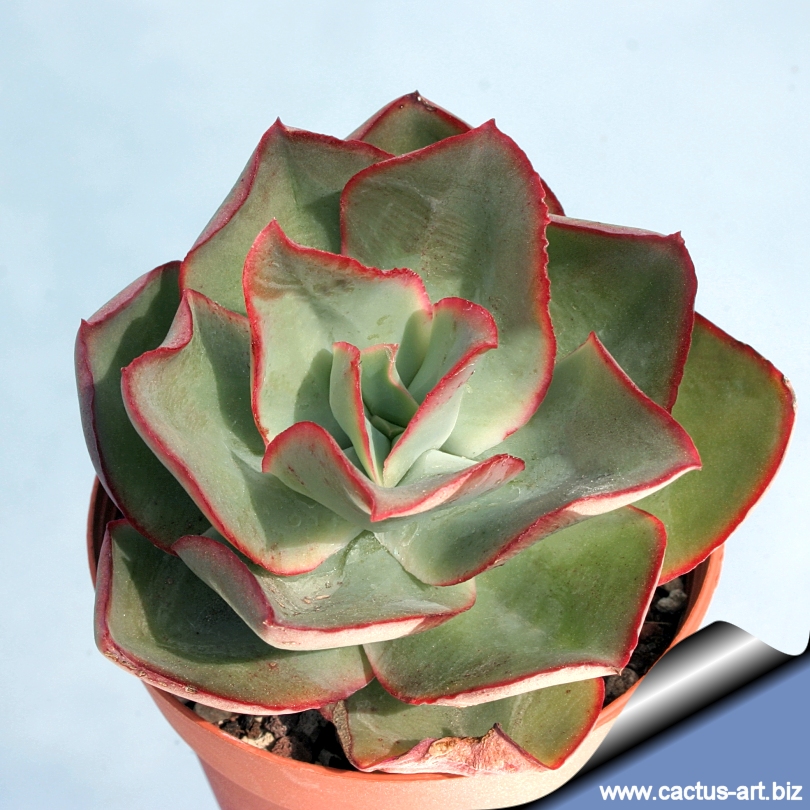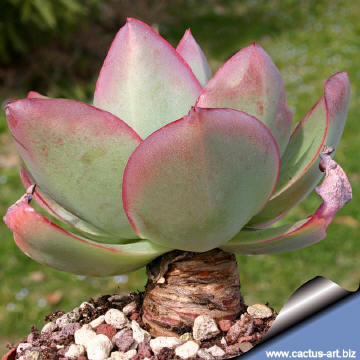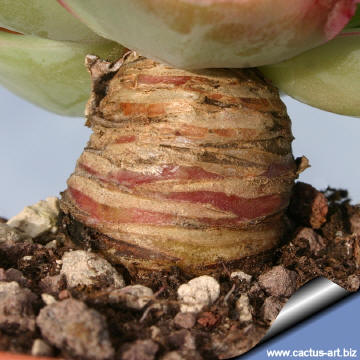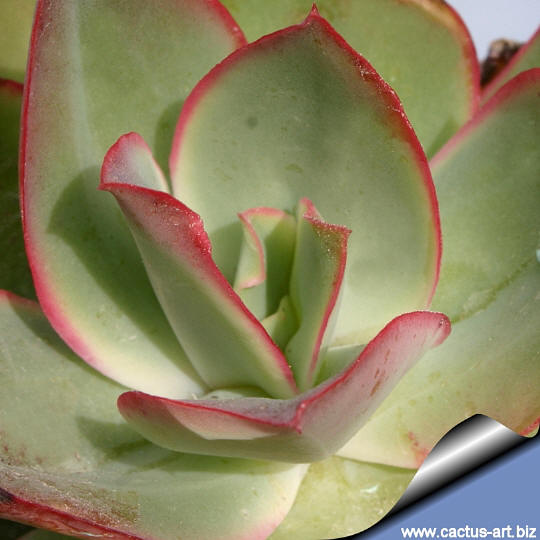|
|
|

Echeveria
rubromarginate is one of the most
handsome and district of echeverias,
its attractiveness
lies in the beautifully red-edged leaves.
|
|
Description: E.
rubromarginata is a slow growing and unusual species. It has
succulent
rosettes, up to 25 x 30 cm in
diameter and tall, it stay usually
solitary but it can occasianally offset to form a small clump.
Stem: Stout, caudex-like, very short (almost
stemless) it can slowly grow up to 5-7 cm tall, and approx 3 cm
in diameter.
Leaves: 11-17 long, 7-9 cm wide, turgid,
obovate or widely lanceolate, obtuse and mucronate to acute
silvery-grey to pale green (slightly glaucous), with pink to purple-red
slightly wavy margin:
Flowers: Red, yellow inside. The inflorescence is a 6-12 branched
cymose-panicle, up to 1 m tall. Each branch bears about 5 flowers.
Pedicel reddish 1-2 mm long, sepals up to 13 ascending, calix up to 14
mm long, approx 11 mm in diameter, petals red.
|

The succulent whorl of leaves is born on the top of a |

short caudex-like stem banded by old leaves scars. |
|


Advertising
|
|
|
|
|
Family: Crassulaceae
Scientific name: Echeveria
rubromarginata Rose
In: (N. L. Britton & al. Eds.) North Amer. Fl. 22(1):
23. 1905.
Type locality: Orizaba,Veracruz-Puebla, Mexico
Habitat: Grows in quite hot and dry areas.
Etymology: The genus Echeveria is named after the 18th
century Spanish botanist Atanasio Echeverria Codoy.
The species name rubromarginata comes from
latin 'ruber'; 'red, ruddy' + Latin
connective vowel 'o' used in botanical Latin, usually for Greek
words but in some cases, such as colour tingeing, for Latin words and
Latin 'marginatus' furnished with a border;
bordered, enclosed with a margin. Literary meaning "Red margined"
Synonyms:
|
|
|
|

Rarely
offsetting, it has thickened, silvery-grey with nice
red edges.
|
|
Cultivation: it can tolerate sun to shade but - generally speaking -
the more light a plant gets the better it will display its colours and
shape. However, when moving plants from lower light conditions into full
sun, be wary of sun scorch, most easily avoided by ensuring plants are
well-watered before moving them on a cloudy day. They can tolerate
extended dry periods and survive drought without the need for watering,
but they will grow stronger if they receive adequate moisture during
their growing season, ut never allowing the plant to remain waterlogged
(root rot sensitive). Use a very porous soil, which will allow quick
drainage. Slow release fertilisers with a low to moderate nitrogen
content are adequate for the spring and summer growing seasons, and
additional fertiliser applications would not required until spring. Good
air movement is important for minimising pest and disease risks, and
avoiding excessive humidity in cool winter conditions is important to
successfully growing Echeveria in the nursery environment. It can
tolerate light frosts, but it is best overwintered at 5-10 °C.
With the cooler autumn temperatures tending to make their foliage
colours become more intense than those of the active summer growing
season.
Aphids like this plant (and all flowering Echeverias).
Propagation: Usually by
seeds, but If the plant is
repotted some of the bottom leaves can be removed, in order to
attempt
leaf propagation, it is also a common practice to collect the leaves
on the
flower stem. However this is not one of the
easiest
species to root, as many such
cuttings will dry out without producing a
plantlet, but with perseverance it is likely
to get a few new plants. Needs good
drainage |
|